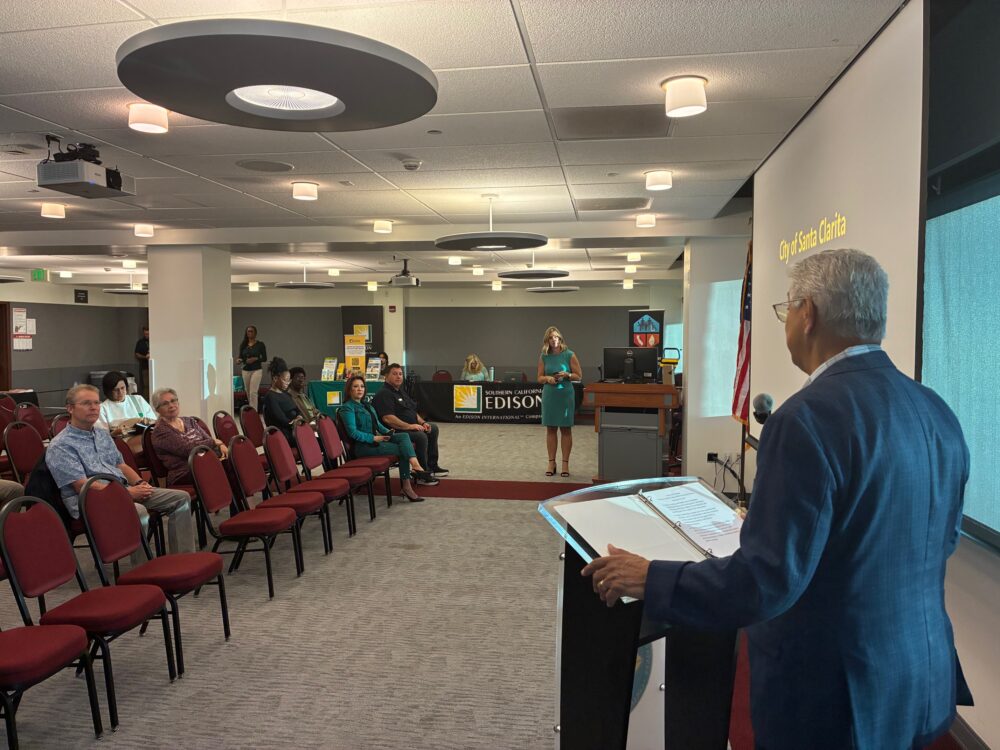
Southern California Edison officials Monday talked about the progress they’ve made on reducing the impacts of the controversial “public safety power shutoffs” and why they had so many challenges during the January wildfires.
But officials stopped short of giving direct answers on a timeline for the completion of local circuit hardening and undergrounding, which are considered the two biggest ways SCE can avoid future public safety power shutoffs.
The sparsely attended meeting, which was announced the previous week, included a mother upset that her home’s power system was damaged from a lack of notice on the shutoffs and a business owner considering leaving the Santa Clarita Valley.
Nick Mairose said he had one power outage in 10 years while his post-production company was in Burbank, when a car crashed into a transformer outside his office. Since moving to Centre Pointe Parkway in 2018, he’s had 20, he said.
He said he’s been told a backup generator strong enough to power his business through a multiday outage is more than a quarter-million dollars, and the outages are happening frequently enough that it’s a cost he’s weighing against relocation, at this point.
The lack of information during the January outages also was very frustrating, he said, particularly when he drove around during the last outage and saw everyone around him with power except him and the other tenants of his specific business park.
Lori Blackwell, principal manager of customer service operations for SCE, said there shouldn’t be gaps in information like that, but the utility was still learning from its recent experience with wildfires.
“In January, for example, that was when there was PSPS, there were repair outages happening with the windstorm. And you know, it took us a while to be able to allocate crews to the different areas, and you know, we were in full triage mode,” Blackwell told Mairose. “And so if, if what you were describing was during January, that would make sense to where we’re not providing an ETA for a long period of time, because we are so strained in the resources with what’s happening across the service territory. But you should be able to report the outage and be getting current and accurate information about your outage and your restoration.”
An SCE official also noted the Hillfield Circuit was part of a plan that had already seen progress since January, with engineers able to segment the lines so that any future outage would affect a smaller number of customers. The goal for the plan was a “100% reduction” in customer outage time, but officials were not able to give a final completion date for any of the work.
Stephanie Kennedy said she read about the meeting in the newspaper and held the circuit board from her refrigerator in a plastic bag. She had to learn how to replace it after a surge fried it when the power was restored during a January outage.
“I’m not going to bother talking to anybody, but I’m here to alert other people, because this can affect a lot of people, and a lot of people don’t have money to deal with unexpectedness just from a power basically being restored,” she said, “and it shouldn’t knock out your vital appliances.”
The utility also tried to address some of the more common concerns it had heard since the PSPS outages began, including, “‘My neighbor has power, and I don’t: Why is that?’” said Ray Fugere, director of asset and system intelligence for SCE.
Fugere pointed to a circuit map behind him laid over homes, which showed how different circuits operated alongside each other, sometimes within the same neighborhood.
“In this scenario, this orange line goes in and out of high fire (area), and it’s shut off for PSPS,” he said, and then pointing to an adjacent circuit coming from a different direction, he said, “This circuit is not a significant circuit. It’s not in a high fire area.
“So sometimes two people right next door to each other could be fed by different circuits, and that’s why one could have power and one could not,” he added.
When pressed for a timeline, SCE officials declined to state any specifics, but they identified two different timelines when it came to the projects: circuit hardening, which can take 18 months to two years to complete from plan to build; and undergrounding, which is much more difficult and can take three to four years.



